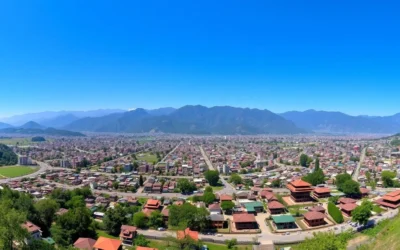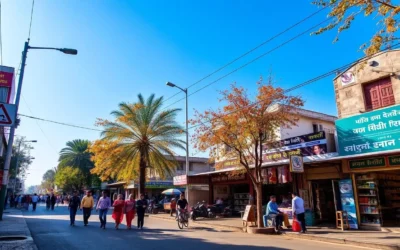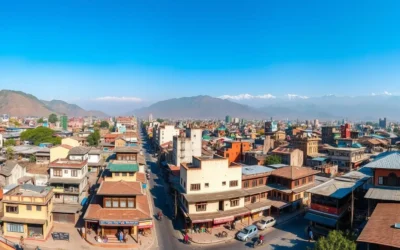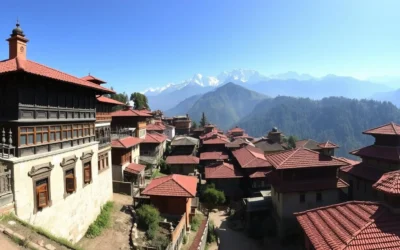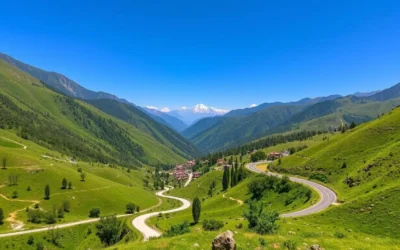✓ Accommodations✓ Flights✓ Rental Cars✓ Tours & Activities
Nestled near Kathmandu, Kirtipur is a cultural treasure that offers a genuine taste of Nepalese life, untouched by the crowds that flock to more popular destinations.
This ancient city, founded in the 3rd century, boasts a rich history, traditional Newari culture, and stunning architecture. As you wander through its streets, you’ll be immersed in a world where tradition meets tranquility.
From historical sites to religious monuments, and from cultural experiences to culinary adventures, Kirtipur promises an unforgettable journey. This guide will walk you through the top places to visit, insider tips on making the most of your experience, and practical information to ensure a seamless trip to this captivating city.
Discovering Kirtipur: Nepal’s Hidden Cultural Gem
As you step into Kirtipur, you’re not just visiting a place; you’re stepping into a living, breathing museum of Nepal’s past. This ancient city, founded in the 3rd century, is a treasure trove of history and culture.
A Brief History of Kirtipur
Kirtipur’s history is as rich as it is fascinating. The city flourished during the Malla period as a center of trade and culture, playing a significant role in Nepal’s unification under King Prithvi Narayan Shah in the 18th century. Its strategic location on a ridge has shaped its development over time, making it a unique blend of historical significance and cultural heritage. The city’s Newari architecture, characterized by narrow alleys lined with traditional houses and temples showcasing intricate woodwork, is a testament to its rich past.

Why Kirtipur Deserves Your Attention
Kirtipur remains one of the most authentic cultural experiences in the Kathmandu Valley, having preserved its traditions better than many neighboring areas. The city’s temples and religious sites continue to play a vital role in local life, offering visitors a glimpse into authentic Nepalese culture. By visiting Kirtipur, you’re not only exploring a historical place but also experiencing the essence of Nepalese life, making it a must-visit destination for anyone interested in history, culture, and traditional architecture.
Planning Your Visit to Kirtipur
To make the most of your visit to Kirtipur, it’s essential to plan ahead, considering the time of year and your travel arrangements. Kirtipur, being a short ride from Kathmandu, offers a serene escape from the city’s bustle.
Best Time to Visit
The best time to visit Kirtipur is during the spring (March-April) and autumn (October-November). These seasons offer clear mountain views and pleasant temperatures, making them ideal for exploring this ancient place. In contrast, the monsoon season (June-September) can make navigating the narrow streets a bit challenging due to rain.
How to Get There
Getting to Kirtipur is relatively straightforward from Kathmandu. You can take a public bus, taxi, or arrange for private transportation. The journey takes approximately an hour by road, depending on traffic. Public buses are an affordable option, while taxis offer a more direct and convenient way to reach this historic city.
Getting Around Kirtipur
Once in Kirtipur, the compact city center is best explored on foot. The narrow streets and hilly terrain can be challenging, but walking allows you to absorb the local culture and history. For those with mobility issues, it’s worth noting that Kirtipur’s uneven pathways may present some challenges.

Explore Kirtipur Durbar Square

As you step into Kirtipur Durbar Square, you’ll discover a less crowded yet equally captivating alternative to Kathmandu’s famous Durbar Square. This historic square is a treasure trove of Nepal’s rich cultural heritage, boasting stunning temples and traditional Newari architecture that tell stories of the city’s rich past.
Historical Significance and Architecture
The Durbar Square in Kirtipur was once the royal center of the independent Kirtipur kingdom before Nepal’s unification. It showcases distinctive Newari architectural elements, including multi-tiered temples, intricate wood carvings, and traditional construction techniques that reflect the craftsmanship of the Newari people.
The square’s architecture is a blend of religious and royal influences, with structures that have been preserved over centuries. The use of wood carvings and traditional construction techniques adds to the square’s historical significance.
Must-See Temples and Structures
One of the must-see temples within the square is the Bagh Bhairav Temple, dedicated to the tiger manifestation of Lord Shiva. It is considered one of the most important religious sites in Kirtipur. Visitors can also explore other significant structures within the square, each with its own cultural and historical importance.
The various temples and structures within Durbar Square continue to play a vital role in local religious practices and festivals. Visitors can experience the vibrant cultural life of Kirtipur by witnessing or participating in these events.
When planning your visit, note that the square is open throughout the day. Guides are available and recommended to gain a deeper understanding of the historical and cultural significance of the various temples and places within the square. The best times to visit are early morning or late afternoon to avoid the heat and experience the local life centered around these historic places.
Photography is allowed, but visitors are expected to behave respectfully, especially when visiting active religious sites within the Durbar Square. Capturing the intricate architecture and the vibrant local life makes for memorable experiences.
Visit the Ancient Buddha Stupa

As you explore Kirtipur, one of the most significant spiritual landmarks you will encounter is the ancient Buddha Stupa. This sacred site is not only a crucial part of Kirtipur’s cultural heritage but also a place where you can experience the profound spirituality of the region.
The Spiritual Importance
The Buddha Stupa is a revered site for both locals and pilgrims, holding deep historical and religious significance. Its architectural elements are reminiscent of other famous stupas in Nepal, such as the Boudhanath Stupa, yet it boasts unique features that set it apart. The stupa’s structure represents various aspects of the Buddha’s teachings and path to enlightenment, making it a fascinating spot for those interested in Buddhist cosmology.
Visitors can observe spiritual practices around the stupa, including circumambulation (walking clockwise around the structure) and prayer offerings. These practices create a vibrant and spiritual atmosphere, allowing you to immerse yourself in local customs and traditions.
Panoramic Views of the Valley
One of the highlights of visiting the Buddha Stupa is the breathtaking panoramic view of the Kathmandu Valley it offers. From this vantage point, you can see the vast expanse of the valley, making it one of the best viewpoints in the area. The stupa is particularly stunning during sunrise or sunset, when the changing light casts a golden glow over the landscape.
The area around the Buddha Stupa has developed into a popular spot for travelers, with numerous hostels, cafes, and gathering places. This makes it an ideal location to relax and soak in the local culture after exploring the stupa.
Visiting the Buddha Stupa is an enriching experience that combines spirituality, history, and natural beauty. Whether you’re interested in the religious significance, the architectural details, or simply the serene atmosphere, this ancient stupa is a must-visit destination in Kirtipur.
Experience Chilancho Stupa’s Tranquility

Experience the tranquility of Chilancho Stupa, one of Kirtipur’s best-kept secrets. Unlike the bustling Boudhanath Stupa, Chilancho Stupa offers a serene and intimate spiritual experience, making it a peaceful place for reflection.
Hidden Gem of Kirtipur
Chilancho Stupa is distinguished by its intricate carvings and unique architectural features. As you explore this hidden spot, notice the detailed craftsmanship that adorns the stupa, reflecting the rich cultural heritage of Kirtipur. This stupa is not just a religious site but also a community space where locals gather for various ceremonies.
Surrounding Greenery and Peaceful Atmosphere
The stupa is surrounded by lush greenery, creating a peaceful space that invites meditation and contemplation. Visitors can enjoy the serene atmosphere, take photographs, or simply sit back and relax. The tranquil environment makes it an ideal spot to escape the hustle and bustle of daily life.
To visit Chilancho Stupa, you can easily walk from Kirtipur’s city center. The local community welcomes visitors, and you may observe or respectfully participate in the rituals and offerings specific to this stupa. As one of the lesser-visited stupas, Chilancho Stupa provides a unique and enriching experience for those seeking a deeper connection with Kirtipur’s Buddhist heritage.
Kirtipur, Nepal: Best Things to Do – Top Picks for Food Lovers
Kirtipur offers a culinary journey like no other, with its authentic Newari cuisine being a highlight of the Kathmandu Valley. As you explore this ancient city, you’ll have the opportunity to indulge in a variety of traditional dishes that showcase the rich cultural heritage of the Newari people.
Traditional Newari Cuisine
Newari cuisine is one of Nepal’s most distinctive culinary traditions, and Kirtipur is one of the best places to experience it. Signature dishes include yomari (sweet dumplings), kwati (mixed bean soup), and choila (spiced meat). However, the crown jewel of Newari cuisine is undoubtedly the famous “king curd” or juju dhau, a creamy yogurt that’s a must-try when visiting Kirtipur.
Food plays a significant role in Newari culture, with many dishes connected to festivals, celebrations, and religious ceremonies. For instance, yomari is traditionally served during the Yomari Punhi festival, while kwati is a staple during the Sagan festival. Understanding the cultural context of these dishes can enhance your dining experience.

Best Local Restaurants to Try
For an authentic Newari dining experience, head to Bhimsen, a local favorite known for its traditional dishes. Other recommended restaurants include those that serve a variety of Newari cuisine, offering a range of options for different tastes and dietary preferences.
| Restaurant | Specialties | Price Range |
|---|---|---|
| Bhimsen | Yomari, Kwati, Juju Dhau | $5-$10 |
| Local Eatery | Choila, Newari Thali | $3-$8 |
Visitors can also participate in cooking classes or food tours to deepen their understanding of Newari culinary traditions. These experiences not only allow you to taste local flavors but also learn about the ingredients and cooking techniques that make Newari cuisine special.
Immerse Yourself in Local Culture
With its rich heritage and warm hospitality, Kirtipur is the perfect place to immerse yourself in local culture. The town offers a variety of hands-on experiences that allow you to engage deeply with the community and its traditions.
Momo Making with Local Hosts
The Momo Cooking experience with the women of Kirtipur Community Homestay is a highlight of any visit. You begin with a traditional Newari welcome, followed by an introduction to the ingredients and the fun process of making various shapes and sizes of momos. This hands-on experience not only teaches you how to prepare Nepal’s beloved dumplings from scratch but also provides insight into daily life and food traditions beyond what tourists typically experience.
Working alongside local women, you create opportunities for cultural exchange and making new friends in a warm and welcoming home environment.
Traditional Arts and Crafts Experiences
Kirtipur is also a hub for traditional arts and crafts. You can participate in various activities such as wood carving workshops, where you learn about the ancient tradition of Newari woodwork, and Mithila painting, where you create your own artwork using traditional techniques and motifs. Additionally, pottery making activities allow you to try your hand at the wheel under the guidance of experienced local artisans.
These experiences provide a deeper connection to Kirtipur’s heritage than simply observing or purchasing finished crafts. By participating in these traditional art forms, you support local artisans and help preserve cultural practices that might otherwise be lost to modernization.
Explore Religious Sites and Temples
As you wander through Kirtipur, you’ll discover a wealth of religious sites that showcase the town’s rich cultural heritage. Kirtipur is home to numerous temples and religious places that are steeped in history and spirituality.
Bagh Bhairav Temple

The Bagh Bhairav Temple is one of Kirtipur’s most important religious sites, dedicated to the tiger manifestation of Lord Shiva. This temple is renowned for its historical and spiritual significance, featuring intricate wood carvings and religious artifacts that reflect the rich artistic history of the region.
Ongoing religious practices at Bagh Bhairav Temple make it a central spot in the spiritual life of Kirtipur’s residents. Visitors can observe daily rituals and ceremonies, gaining insight into the local culture and history.
Buddhist Monasteries Worth Visiting
Kirtipur is also home to several Buddhist monasteries that offer a glimpse into Buddhist practices and provide a unique cultural experience. These monasteries are significant not only for their historical importance but also for their architectural beauty.
Visitors can observe daily prayer times and meditation sessions at these religious places. Other significant temples in the area, such as Nagadesh Temple, dedicated to the serpent god, offer a more personal experience due to fewer crowds.
Kirtipur exemplifies religious syncretism, where Hindu and Buddhist traditions have coexisted and influenced each other throughout history. When visiting these sites, it’s essential to dress appropriately, behave respectfully, and follow photography guidelines. Donations are often appreciated at these religious sites.
Shop at Local Markets
As you wander through Kirtipur’s bustling markets, you’ll discover a world of vibrant colors, enticing aromas, and unique handicrafts. The local markets are essential places to experience authentic city life and interact with local people going about their daily routines.

What to Buy
The markets in Kirtipur offer a diverse array of goods, from fresh produce and spices to handcrafted items, traditional clothing, and religious artifacts. You can find a lot of unique souvenirs, such as locally made handicrafts, traditional Newari jewelry, or specialty food products that represent the region. Shopping at these local markets is a great way to support the community economy and help preserve traditional crafts and life styles.
Interacting with Local Vendors
When interacting with local vendors, it’s essential to be respectful and mindful of cultural customs. Learning a few basic Nepali phrases, such as “namaste” (hello), can go a long way in building rapport. Bargaining is a common practice in Kirtipur’s markets, but it’s crucial to do so in a respectful manner that honors the craftspeople’s work. By shopping at these local markets, you’re not only finding unique souvenirs but also contributing to the local economy and experiencing the authentic culture of the city.
Where to Stay in Kirtipur
Kirtipur offers a variety of accommodations to suit different traveler preferences and budgets. Whether you’re looking for a social atmosphere, an authentic local experience, or a peaceful retreat, Kirtipur has something for everyone.
Budget Accommodations
For travelers on a tight budget, Kirtipur has numerous affordable options. The area around Buddha Stupa is particularly popular among backpackers, with hostels that offer a great spot to meet fellow travelers. You can expect to pay around $5 to $10 USD for a bed in a dorm. Some places may be a bit basic, but they provide a comfortable and social environment.
Homestay Experiences
For a more immersive experience, consider staying in the Chakupat neighborhood, which offers a local feel with budget-friendly guesthouses and homestays. Through networks like the Community Homestay Network, you can live with local families and participate in daily activities, truly experiencing the local culture and connecting with the people and their way of life in your home away from home.
Accommodation options in Kirtipur’s outskirts offer peaceful guesthouses with beautiful views, though they may be less social. When booking, consider whether you prefer a lively atmosphere or a quiet retreat, and choose your place to stay accordingly.
Day Trips from Kirtipur
Kirtipur is a great base for exploring the surrounding region, with many exciting day trip options. The town’s strategic location allows you to easily visit nearby attractions that showcase Nepalese culture, history, and natural beauty.
Nearby Towns Worth Exploring
The nearby town of Sankhu is a great day trip destination, with its historic center and traditional architecture. You can explore the town’s narrow streets, visit local temples, and experience the daily life of the locals. Another significant site is Changu Narayan, one of Nepal’s oldest and most important temple complexes, recognized as a UNESCO World Heritage site. This ancient site is renowned for its rich history and cultural significance.
Some of the unique experiences you can have in these nearby towns include:
- Stone carving workshops where you can learn about traditional Nepalese craftsmanship
- Visiting local markets and interacting with vendors
- Exploring the historic centers and traditional architecture

Hiking Opportunities Around Kirtipur
If you’re looking for outdoor activities, Kirtipur offers several hiking trails that cater to different fitness levels. The trails around Phulchowki, the highest hill in the Kathmandu Valley, provide spectacular panoramic views and are a great way to experience the natural beauty of the area. Whether you’re looking for a leisurely walk or a more challenging hike, there’s something for everyone.
Some tips for hiking around Kirtipur:
- Make sure to wear comfortable shoes and bring plenty of water
- Consider hiring a local guide to enhance your experience and ensure your safety
- Bring sun protection and layers for changing weather conditions
Kirtipur serves as an excellent base for these hiking adventures, providing a comfortable and convenient place to rest and prepare for your next day’s journey.
Practical Tips for Visiting Kirtipur
As you plan your trip to Kirtipur, Nepal, it’s essential to be prepared for an adventure. Kirtipur is generally safe for travelers, but being mindful of your belongings and surroundings is always a good idea.
Your daily budget in Kirtipur can range from $25 to $50 USD, covering basic expenses like accommodation, food, and activities. To stay healthy, drink bottled or purified water and protect your body from the sun. The altitude of the Kathmandu Valley can be challenging, so take necessary precautions.
When visiting temples and sacred spaces, dress respectfully, and remove your shoes before entering homes and temples. Learning a few basic Nepali phrases can enhance your experience and show respect for the local culture. With some preparation and an understanding of local customs, you’ll have a rewarding experience in Kirtipur.
The above is subject to change.
Check back often to TRAVEL.COM for the latest travel tips and deals.

